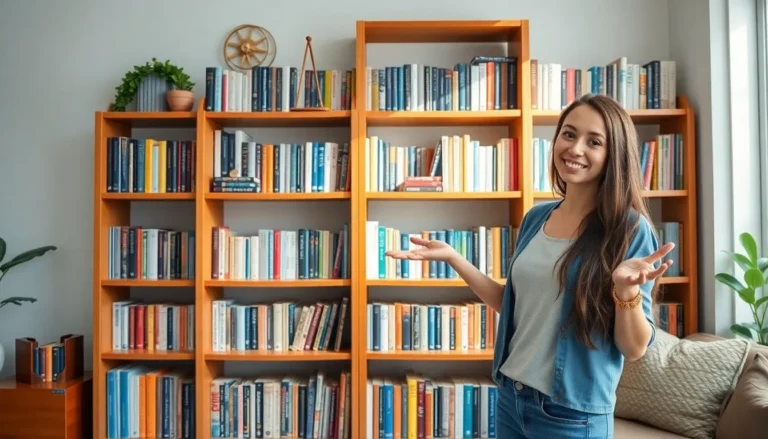Table of Contents
ToggleDreaming of a getaway where the sun kisses your skin and the ocean whispers sweet nothings? Owning a vacation property could be your ticket to paradise. But before you pack your bags, there’s that little matter of the down payment. It’s like the entry fee to your slice of heaven, and understanding it can make all the difference.
Understanding Down Payments for Vacation Property
Down payments for vacation properties typically range from 10% to 30% of the purchase price. Specific mortgage types or lender requirements may influence the exact percentage needed. Analyzing personal finances and budget before committing ensures investors can comfortably manage ongoing costs.
Investors often face stricter criteria when financing a second home compared to a primary residence. Lenders generally consider credit score, debt-to-income ratio, and overall financial stability. Meeting these criteria boosts the chances of obtaining favorable loan terms.
Many buyers consider financing options while assessing their down payment. Conventional loans, FHA loans, and personal loans offer varied down payment requirements and benefits. Understanding these options allows for informed decisions based on individual circumstances.
Moreover, some homeowners reinforce their investment by allocating savings or liquidating assets for a larger down payment. Increased down payments can lead to lower monthly mortgage payments and potentially better interest rates. Investors also find that larger down payments help build equity more quickly.
Exploring programs designed for vacation property purchases can also provide potential benefits. Various assistance programs or grants might exist to help with down payments and closing costs. Researching local resources may uncover opportunities to reduce initial financial burdens.
Assessing the overall costs of ownership helps prospective buyers set a realistic down payment goal. This assessment includes not only the immediate purchase price but also property taxes, insurance, and maintenance costs. A well-rounded financial plan directly contributes to sustaining the vacation property over the long term.
Importance of Down Payment in Real Estate
Down payments play a vital role in real estate transactions, especially for vacation properties. They can significantly affect the buying process and long-term financial health.
Impact on Mortgage Approval
Lenders closely examine down payment amounts when approving mortgages. A higher down payment often leads to improved loan terms. It demonstrates financial stability and reduces the risk for lenders. Buyers commonly face fewer hurdles in securing financing with a substantial down payment. Those with lower down payments might encounter additional scrutiny and stricter requirements. Documentation such as credit scores and debt-to-income ratios becomes more critical in these cases.
Financial Implications
Down payments directly influence monthly mortgage payments and overall ownership costs. A larger down payment leads to lower monthly mortgage payments, allowing for better financial management. Additionally, it decreases the total interest paid over the life of the loan. Individuals who provide 20% or more of the property’s value can often avoid private mortgage insurance, further reducing expenses. Thus, setting a down payment goal based on financial comfort helps maintain budget control. Understanding these implications aids in making well-informed decisions regarding vacation property investments.
Typical Down Payment Percentages
Understanding down payment percentages is crucial for purchasing a vacation property. Typically, these vary between 10% and 30% of the property’s purchase price.
Conventional Loans
Conventional loans usually require a down payment between 10% and 20%. Many lenders prefer a minimum of 20% to avoid private mortgage insurance. Offering a higher down payment can lead to better mortgage terms and reduce monthly payments. Notably, those who invest more upfront often build equity in the property more quickly. Lastly, individual financial situations and lender requirements may affect these percentages.
FHA Loans
FHA loans set a lower barrier for entry with down payments as low as 3.5%. Such loans provide options for buyers with less-than-perfect credit scores. While the smaller down payment attracts many, additional costs such as mortgage insurance premiums may apply. Borrowers aiming for an FHA loan should present clear financial documentation for approval. Furthermore, these loans enhance accessibility, making vacation home ownership achievable for a broader audience.
Factors Influencing Down Payment Requirements
Several key factors influence down payment requirements for vacation properties. Understanding these elements can make the home-buying process clearer.
Property Type
Different property types come with varying down payment expectations. For single-family homes or condos, lenders typically require down payments of 10% to 20%. In contrast, multifamily properties can demand higher down payments, often around 25%. Investors looking into luxury vacation homes may also face elevated down payment percentages, sometimes reaching 30%. Properties in need of extensive repairs often fall under stricter financing criteria, impacting down payment requirements significantly.
Location
Location greatly affects down payment standards. In high-demand vacation hotspots, sellers often favor buyers offering substantial down payments, resulting in competition for properties. Rural or less desirable locations typically allow for lower down payments, sometimes as low as 10%. Economic conditions and local market trends also factor into down payment needs; areas with burgeoning real estate markets might encourage investors to put down larger amounts to secure favorable financing options.
Buyer’s Financial Profile
A buyer’s financial profile plays a critical role in determining down payment requirements. Lenders assess credit scores, with higher scores often leading to lower down payment expectations. Those with strong debt-to-income ratios may secure loans with reduced down payment amounts, potentially as low as 10%. Conversely, investors with lower credit scores frequently face higher down payment demands, sometimes exceeding 20%. Documenting income stability and demonstrating financial health can afford buyers more favorable terms, enhancing their chances of achieving their vacation property goals.
Strategies for Saving for a Down Payment
Saving for a down payment on a vacation property requires thoughtful planning and disciplined financial strategies. Effective budgeting methods combined with exploring assistance programs can significantly aid in reaching that financial goal.
Budgeting Tips
Creating a detailed budget serves as the foundation for saving funds. Start by identifying monthly income and fixed expenses, then allocate a specific percentage of income toward the down payment savings goal. Cut unnecessary expenses, like dining out or subscription services, to increase savings potential. Set a realistic timeline to achieve the desired down payment percentage. Regularly reviewing and adjusting the budget ensures progress remains on track. Automation can also simplify the process by transferring a set amount directly into a savings account each month. These practices make the saving journey manageable and effective.
Assistance Programs
Various programs provide financial assistance to help ease the burden of down payments. Local housing authorities often support first-time buyers through grants or low-interest loans. Additionally, some nonprofit organizations offer down payment assistance specifically for vacation homes. Federal Housing Administration (FHA) loans feature reduced down payment options, appealing to buyers with lower credit scores. It’s crucial to research eligibility requirements and application procedures for these programs to maximize available resources. By leveraging these assistance options, prospective buyers can significantly reduce the upfront costs associated with purchasing a vacation property.
Investing in a vacation property can be a rewarding experience when approached with careful planning. Understanding the down payment requirements is essential for making informed decisions. By considering various financing options and setting realistic savings goals, potential buyers can navigate the complexities of securing their dream getaway.
The right down payment not only influences mortgage approval but also impacts long-term financial stability. With the right strategies and resources, owning a vacation home can become a reality. Whether through conventional loans or assistance programs, taking the time to assess personal finances will pave the way for a successful investment in a cherished retreat.







